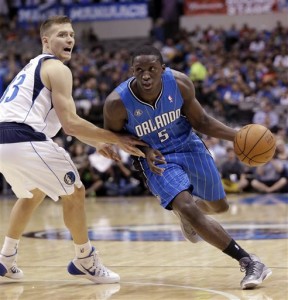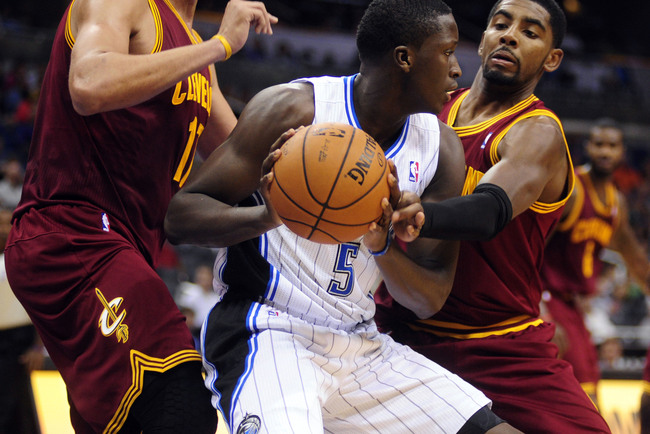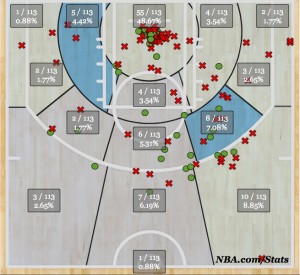 When Victor Oladipo was taken second overall in the 2013 draft by the Orlando Magic, everyone assumed he would play shooting guard in the NBA. His 6-4 frame and 214 pounds projected perfectly for the NBA’s new wave of shooting guards.
When Victor Oladipo was taken second overall in the 2013 draft by the Orlando Magic, everyone assumed he would play shooting guard in the NBA. His 6-4 frame and 214 pounds projected perfectly for the NBA’s new wave of shooting guards.
However, over the summer, the Magic made it clear they would experiment with Oladipo by slotting him into a dynamic combo guard role.
As a result, Oladipo has been featured more at the point than at any time in his basketball life. Perhaps unfairly, Oladipo’s difficult transition to become a facilitator has been largely understated – likely as a product of fans assuming any elite athleticism can just learn the position.
So far, his work at point guard has seen mixed reviews. Yes, he’s been able to lock down on opponents, generating three points off turnovers per game and posting a highly respectable defensive rating of 94.0. Oladipo’s defensive skills, however, were never really in question. He is merely validating the widespread speculation that he will be a very good NBA defender.
The real concern with Oladipo at point guard comes on the other end of the court. Through his first ten games, he is averaging 4.0 turnovers and is accounting for more than a third of his team’s giveaways when he’s on the court, per NBA.com. He’s also committed seven more turnovers (40) than assists (33).
Now, this is not an end-all be-all dilemma; many players struggle to control the ball early in their careers.
However, the way in which Oladipo is committing these turnovers is troubling. He has a tendency to telegraph passes, which rewards anticipatory defenders with easy points in transition.

Per 100 possessions, opponents have scored 21 points off turnovers (15.4 coming in transition) when Oladipo is on the court.
Those numbers aren’t completely his fault. His team is young and experiencing growing pains all around. However, what it means is that if Oladipo wasn’t responsible for so much of Orlando’s offense, his defensive rating would instantaneously move into elite company.
“[Turnovers are] part of the process,” acknowledged Magic guard Arron Afflalo. “He’s been trying to ball handle a little bit more. I don’t know how much ball handling he did in college, but his playmaking is always a possibility and teams are going to try to take him out of his rhythm because of it.”
As with any player, more experience should give Oladipo more confidence with decision-making on the court. Still, the point guard position is particularly foreign to him.
For all intents and purposes, Oladipo has played small forward his entire life. Last year at Indiana, Yogi Ferrell and Jordan Hulls handled the facilitating duties, as evidenced by Oladipo’s low Usage Rate of 22 percent.
Essentially, Oladipo was featured in about a fifth of his team’s plays when on the court – well behind Cody Zeller and barely ahead of Christian Watford and Will Sheehey in Tom Crean’s offense.
Compared to his current 27.9 percent Usage Rate with the Magic, it is obvious why Oladipo has struggled: He is playing much tougher competition at a much more demanding position.
Orlando coach Jacques Vaughn wants Oladipo to continue to get looks as a facilitator for at least the remainder of this season.
“He’s still progressing,” Vaughn said. “We’ve put the ball in his hands about half of the game right now to let him orchestrate the offense. Overall, he’s been good for us. It’s a tough position to play, so we’re going to continue to push him and challenge him. We’ll be putting the ball in his hands, whether or not that’s at point guard or on the wing.”
Putting the ball in Oladipo’s hands has historically limited him offensively. Oladipo has always been at his best when he has the freedom to slash toward the hoop without the ball. Also, he’s far more effective in catch-and-shoot situations than when trying to create for himself of the dribble. (As evidenced in Orlando, where 77.8% of Oladipo’s threes have been assisted on so far.)
With the ball in his hands and the responsibility to set up for other players, Oladipo’s opportunities to convert from the arc have been limited. Although he is a pretty good shooter (37.5 percent from deep), he is only attempting 2.4 3-pointers a game.
Still, Oladipo is embracing the challenge of a new position, even if it has limited his offense.
“[The transition has] been pretty good,” said Oladipo. “It’s just a process of taking it one day at a time and continuing to work on it.”
Oladipo’s 5.2 assists per 40 minutes suggest he has done a decent job of distributing in limited time. However, when looking at his distribution chart for the season, it is clear he has been highly ineffective at setting his teammates up on shots outside of five feet. Take a look for yourself:
Oladipo simply doesn’t have the timing or awareness to set up his teammates for high-percentage shots at the moment. He has been fairly successful at setting up his teammates at the hoop, but that’s something he thrived at as a slasher in college.
As I’ve discussed in the past, the NBA is loaded with quality point guards. Trying to convert Oladipo, who is so clearly better suited to play off the ball, puts him on a steep learning curve. Just because Oladipo in theory is skilled and athletic enough to become a good NBA point guard doesn’t mean he should play the position permanently.
However, if Orlando is merely using Oladipo at point guard in the interim until a new point guard is brought in (through the draft or free agency), it could ultimately be a smart decision for the team.
Orlando knows its not ready to contend for a championship this season. Giving Oladipo a season to work on his ball handling and offensive creativity certainly isn’t the worst thing for his development. With the success of shooting guards serving as secondary facilitators in Houston and Golden State, teams are starting to embrace two-facilitator lineups. And with Oladipo manning the point, Orlando is likely headed back to the lottery in 2014 – when point guards Marcus Smart, Dante Exum and Andrew Harrison could all be available.
With a dominant rebounder in Nikola Vucevic, a premier young scorer in Tobias Harris and several other nice young pieces, Orlando has the foundation in place to become a contender some day.
Teammates believe Oladipo’s development will be a big factor to the extent of success in that future.
“He’s got unlimited potential right now,” said forward Jason Maxiell. “The time he has ahead of him at his age and the size and athleticism he has already means he’ll be playing for a long time.“
Jacob Eisenberg is a junior at Emory University and works as a credentialed reporter at Atlanta Hawks games. Check out his website here and be sure to follow him on twitter @eisenberg43.

First off I would like to say superb blog! I had a quick question that I’d like to ask if you don’t mind.
I was curious to know how you center yourself and clear your head before writing.
I have had difficulty clearing my mind in getting my thoughts out.
I do enjoy writing but it just seems like the first 10 to 15 minutes are wasted simply just trying to figure out how to begin.
Any suggestions or tips? Kudos!
Yeah. No joke. Oladipo has looked good as a player even when he’s in the pg spot, but he looks like a god awful point guard. Terrible timing, no feel for when to pass with poor accuracy, and more or less a terribly unskilled dribbler.
For me this is all deja vu, as when Mr. Dwight was a rookie, he looked completely terrible. The guy who I enjoyed watching instead of Howard — Jameer Nelson.
Basically, Olapido might learn the position, but even if he doesn’t, there’s no better way to improve your weaknesses and develop as a player than have the faith of your coaches as you learn and make mistakes. This may be the equivalent to body punches in boxing to the rest of the league when later-than-sooner Orlando and Oladipo’s sacrifices start paying dividends.